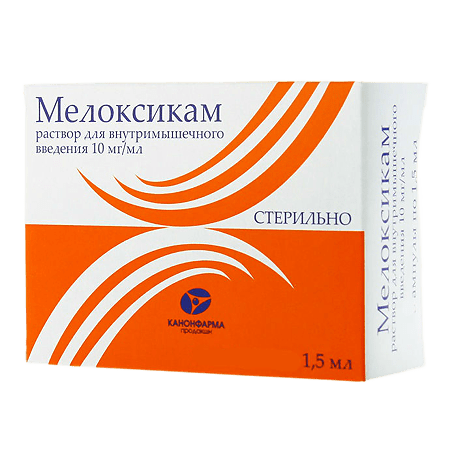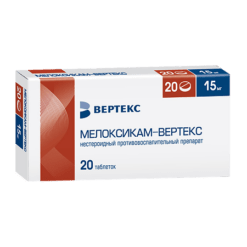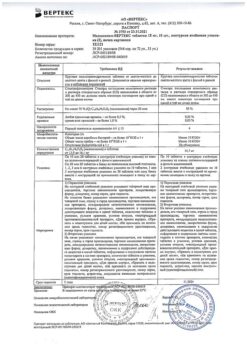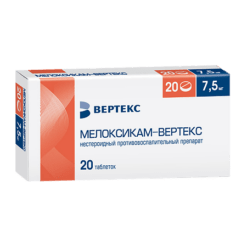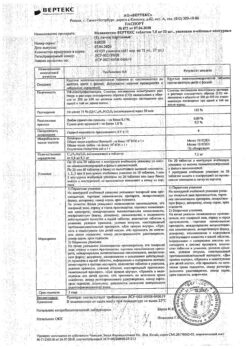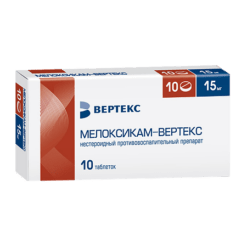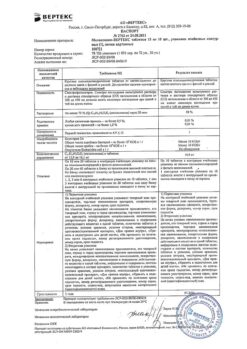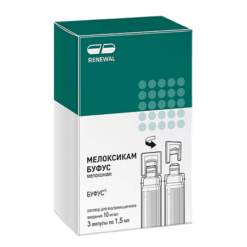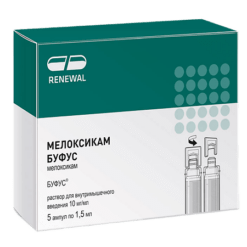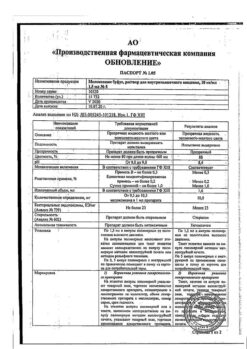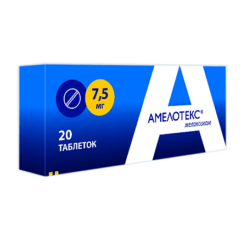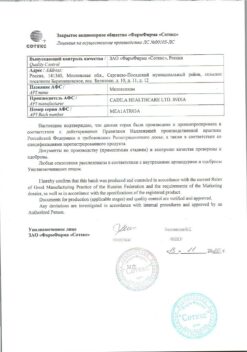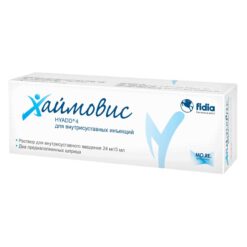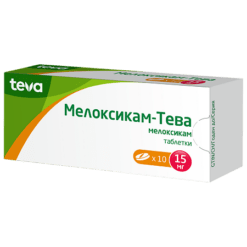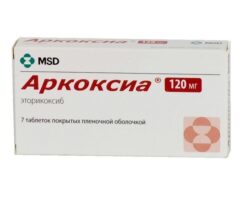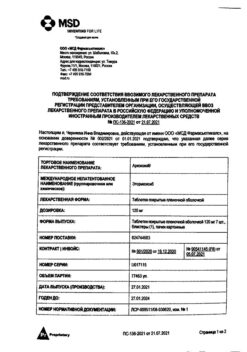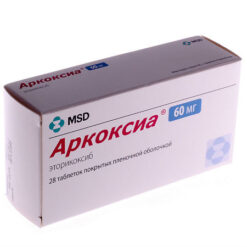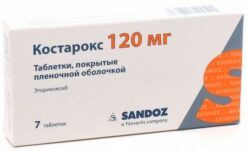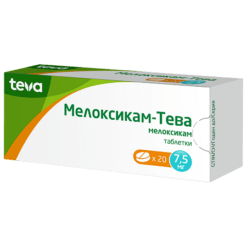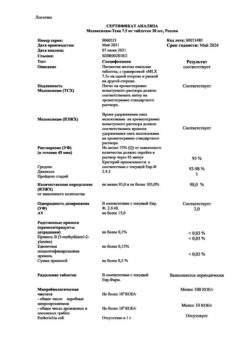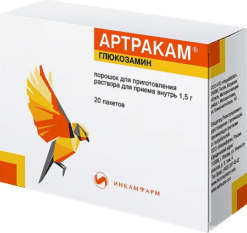No products in the cart.
Meloxicam, 10 mg/ml 1.5 ml 5 pcs
€1.00
Out of stock
(E-mail when Stock is available)
Description
Osteoarthritis and arthritis, Pain, Pain after injuries and operations, Joint pain (arthralgia), Osteochondrosis, Rheumatoid arthritis, Periarthritis, Osteoarthritis, Sciatica, Lumbago, Radiculitis, Pain in the neck, Back pain
Rheumatoid arthritis; osteoarthritis; ankylosing spondylitis (Behterev’s disease) and other inflammatory and degenerative joint diseases, accompanied by pain syndrome.
It is intended for symptomatic therapy, reduction of pain and inflammation at the time of use; it has no effect on the progression of the disease.
Active ingredient
Active ingredient
Composition
Composition
1 ml of the solution contains:
active ingredients:
meloxicam 10.00 mg/mL
excipients:
Glycine (aminoacetic acid),
macrogol (polyethylene glycol 400),
Meglumine (N-methyl-D-glucamine),
povidone-K 17 (plasdon C-15 or collidone 17 F),
1,2 – propylene glycol,
sodium hydroxide,
water for injection.
How to take, the dosage
How to take, the dosage
Intramuscular administration of Meloxicam is reasonable during the first 2-3 days of treatment. Thereafter, the drug should be switched to oral administration.
The recommended dose of Meloxicam for injection is 7.5 mg or 15 mg/day depending on the intensity of pain syndrome and severity of inflammation. The maximum recommended daily dose should not exceed 15 mg.
In patients with severe chronic renal failure who are on hemodialysis, the dose of Meloxicam should not exceed 7.5 mg/day.
Given that no dosage regimen has been established for children and adolescents under 15 years of age, Meloxicam is prescribed only for adults and adolescents over 15 years of age.
Meloxicam should be administered by deep intramuscular injection. It should not be used intravenously.
Interaction
Interaction
Simultaneous use with other NSAIDs increases the risk of gastrointestinal ulcers and gastrointestinal bleeding.
Concomitant use of NSAIDs with lithium preparations increases the concentration of lithium ions in the blood plasma due to reduced renal excretion of lithium. If such combination therapy is necessary, it is recommended to monitor plasma lithium ion levels at the beginning of treatment, during dose adjustment and withdrawal of meloxicam.
Meloxicam reduces the effectiveness of intrauterine contraceptives (IUDs), hypotensive drugs. Indirect anticoagulants, ticlopidine, heparin, thrombolytics increase the risk of bleeding. Methotrexate increases myelodepressive effects; diuretics increase the risk of renal dysfunction; cyclosporine increases nephrotoxic effects; colestyramine accelerates excretion. Myelotoxic drugs increase the manifestation of hematotoxicity of the drug.
Special Instructions
Special Instructions
In case of peptic ulcers or gastrointestinal bleeding, development of skin and mucous membrane side effects, the drug should be discontinued.
. In patients with decreased circulating blood volume (DCV) and glomerular filtration (dehydration, CHF, cirrhosis, nephrotic syndrome, clinically expressed renal diseases, use of diuretics, dehydration after major surgery) there may be clinically manifest CPN which is completely reversible after discontinuation of the drug (daily urine output and renal function should be monitored in such patients during the beginning of treatment). In case of persistent and significant increase in transaminases and changes in other liver function parameters, the drug should be discontinued and control tests should be performed. In patients with increased risk of side effects, treatment should be started with a dose of 7.5 mg. In terminal stage of CKD in patients on dialysis the dose should not exceed 7.5 mg/day. During this treatment it is necessary to be careful when driving motor transport and engaging in other potentially dangerous activities that require high concentration and quick psychomotor reactions (if dizziness or somnolence occur). In order to decrease the risk of gastrointestinal side effects it is necessary to use the minimum effective dose with the shortest possible course.
Contraindications
Contraindications
Hypersensitivity (including to NSAIDs of other groups), combination of bronchial asthma, recurrent polyposis of the nose and sinuses and intolerance to acetylsalicylic acid (ASA) and pyrazolone medicines; gastric and 12 duodenal ulcer (acute phase), severe hepatic insufficiency, chronic renal insufficiency (CKI) in patients not undergoing dialysis (creatinine clearance (CK) less than 30 ml/min), active gastrointestinal bleeding; progressive renal disease, severe hepatic insufficiency or active liver disease, condition after coronary artery bypass grafting, confirmed hyperkalemia, inflammatory bowel disease, childhood age (under 15 years), pregnancy, lactation.
With caution
. Elderly age, coronary heart disease (CHD), chronic heart failure (CHF), cerebrovascular disease, dyslipidemia/hyperlipidemia, diabetes, peripheral artery disease, smoking, IQ less than 60 ml/min, history of GI ulcers, presence of H. pylori, long-term use of NSAIDs, alcoholism, severe somatic diseases, simultaneous use of oral glucocorticoid drugs (including prednisolone), anticoagulants (including warfarin), antiplatelet agents (including clopidogrel), selective serotonin reuptake inhibitors (including citalopram, fluoxetine, paroxetine, sertraline).
Side effects
Side effects
Digestive system disorders: more than 1% – dyspepsia, including nausea, vomiting, abdominal pain, constipation, flatulence, diarrhea; 0.1-1% – transient increase in the activity of “liver” transaminases, hyperbilirubinemia, belching, esophagitis, gastroduodenal ulcer, GI bleeding (including hidden), stomatitis; less than 0.1% – GI perforation, colitis, hepatitis, gastritis.
Hematopoietic organs: more than 1% – anemia; 0.1-1% – blood count changes, including leukopenia, thrombocytopenia.
Skin disorders: more than 1% – itching, skin rash; 0.1-1% – urticaria; less than 0.1% – photosensitization, bullous rash, erythema multiforme, including Stevens-Johnson syndrome, toxic epidermal necrolysis.
Respiratory system disorders: less than 0.1% – bronchospasm.
Nervous system: more than 1% – dizziness, headache; 0.1-1% – vertigo, tinnitus, drowsiness; less than 0.1% – confusion, disorientation, emotional lability.
Cardiovascular system: more than 1% – peripheral edema; 0.1-1% – increase of blood pressure (BP), palpitation, “rushes” of blood to the face.
Ureinary system: 0.1-1% – hypercreatininemia and/or increased serum urea; less than 0.1% – acute renal failure; connection with meloxicam administration is not determined – interstitial nephritis, albuminuria, hematuria.
Sensory system disorders: less than 0.1% – conjunctivitis, visual impairment, including blurred vision.
Allergic reactions: less than 0.1% – angioedema, anaphylactoid/anaphylactic reactions.
Overdose
Overdose
Symptoms: loss of consciousness, gastrointestinal bleeding, acute renal failure.
Treatment: no specific antidotes; symptomatic therapy is indicated.
Similarities
Similarities
Additional information
| Manufacturer | Kanonfarma Production ZAO, Russia |
|---|---|
| Medication form | solution |
| Brand | Kanonfarma Production ZAO |
Other forms…
Related products
Buy Meloxicam, 10 mg/ml 1.5 ml 5 pcs with delivery to USA, UK, Europe and over 120 other countries.

